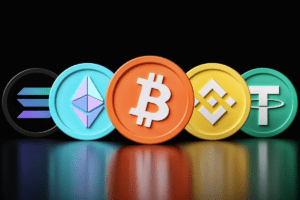Compreender Solana
In order to fully grasp the concept of Solana staking, it’s important to first understand what Solana is and the basics of blockchain technology.
Introdução a Solana
Solana é uma cadeia de blocos de alto desempenho plataforma designed to enable fast and scalable decentralized applications (dApps) and cryptocurrencies. It was created by a team of experts aiming to address the scalability limitations faced by many existing blockchain networks.
One of the key features that sets Solana apart is its ability to process a high throughput of transactions. This is achieved through its unique combination of technologies, including a proof-of-history (PoH) consensus mechanism and a decentralized clock. By utilizing these technologies, Solana is able to achieve high transaction speeds and low fees, making it an attractive option for developers and users alike.
To delve deeper into the technical aspects of Solana, you may refer to the Livro branco Solana for a comprehensive overview of its underlying technology, including its tokenomics, scalability solutions, and roadmap.
Noções básicas sobre a tecnologia Blockchain
Blockchain technology serves as the foundation for decentralized systems like Solana. At its core, a blockchain is a digital ledger that records transactions across multiple computers, known as nodes, in a secure and transparent manner.
In a blockchain network, each transaction is bundled together with other transactions into a block. These blocks are then linked together in a chronological order, forming a chain of blocks. This chain of blocks is maintained and validated by the network’s participants, known as validators.
The security and immutability of a blockchain are ensured through a consensus mechanism. In the case of Solana, it utilizes a proof-of-stake (PoS) consensus mechanism, which requires participants to lock up a certain amount of cryptocurrency as collateral, known as staking, in order to validate transactions and create new blocks.
The decentralized nature of blockchain technology eliminates the need for intermediaries, such as banks, and provides transparency and security to users. It has the potential to revolutionize various industries by enabling decentralized applications, smart contracts, and secure digital transactions.
Now that we have established a foundational understanding of Solana and blockchain technology, we can proceed to explore the power of staking in the Solana network.
The Power of Staking
In the world of cryptocurrencies, staking has emerged as a popular way for investors to earn passive income while supporting the security and functionality of blockchain networks. Solana, a high-performance blockchain platform, offers its users the opportunity to participate in staking and reap the benefits it brings.
What is Staking?
Staking refers to the process of actively participating in the validation and consensus mechanism of a blockchain network by locking up a certain amount of cryptocurrency tokens. By doing so, stakers contribute to the network’s security and operations, and in return, they earn rewards.
In the case of Solana, staking involves holders of SOL, the native cryptocurrency of the Solana network, locking up their tokens to support the network’s operations. Stakers who choose to participate in the Solana staking process have the potential to earn additional SOL tokens as rewards for their contribution.
Benefits of Staking in the Solana Network
Staking in the Solana network offers several benefits to participants, making it an attractive option for cryptocurrency holders:
-
Earning Passive Income: By staking SOL tokens, participants have the opportunity to earn passive income in the form of additional SOL tokens. These rewards are distributed to stakers for their role in maintaining the network’s security and consensus.
-
Contributing to Network Security: Stakers play a vital role in the security and stability of the Solana network. By locking up their tokens and participating in the consensus mechanism, they help to validate transactions and maintain the integrity of the blockchain. This active involvement strengthens the network against potential attacks and ensures the smooth functioning of the ecosystem.
-
Supporting Network Operations: The Solana network is built for scalability and high throughput, aiming to handle a large volume of transactions quickly and efficiently. By staking SOL tokens, participants contribute to the network’s operations, enabling it to continue processing transactions at a rapid pace. This helps to establish Solana as a reliable and robust blockchain platform.
-
Alignment with Solana’s Vision: Staking SOL tokens aligns with the vision of the Solana project, which aims to create a decentralized and scalable blockchain ecosystem. By actively participating in staking, individuals become an integral part of the Solana community, supporting its growth and development.
Staking in the Solana network offers an opportunity for cryptocurrency holders to earn rewards while actively contributing to the security and functionality of the blockchain. However, it’s important to understand the requirements and considerations associated with staking in Solana. To learn more about how staking works in the Solana network, continue reading our article on Solana validators.
How Staking Works in Solana
To fully understand how staking works in the Solana network, it’s important to familiarize yourself with validator nodes and the consensus mechanism used.
Validator Nodes and Consensus Mechanism
In the Solana network, validator nodes play a crucial role in the staking process. These nodes are responsible for validating transactions and maintaining the integrity of the blockchain. Validators ensure that all transactions are legitimate, secure, and comply with the network’s rules.
Solana employs a unique consensus mechanism known as Proof of History (PoH), combined with Proof of Stake (PoS). Proof of History establishes a historical record of events, providing a time-stamping mechanism that helps prevent fraud and enables faster transaction confirmations. Proof of Stake, on the other hand, allows validators to create new blocks and validate transactions based on the number of tokens they hold and are willing to “stake” or lock up as collateral.
Validators are chosen to forge new blocks based on their stake in the network. The more tokens a validator holds and stakes, the higher their chances of being selected. Validators are incentivized to act honestly and maintain the security and stability of the Solana blockchain, as any malicious behavior or failure to fulfill their responsibilities can result in penalties, including losing a portion of their staked tokens.
Requirements for Staking in Solana Network
To participate in staking on the Solana network, there are a few requirements to consider:
-
Solana Tokens: You need to have Solana tokens (SOL) to participate in staking. These tokens can be acquired through various means, including purchasing them from cryptocurrency exchanges or participating in token sales.
-
Solana Wallet: You will need a Solana wallet to store your SOL tokens and interact with the Solana network. There are several wallets available that are compatible with Solana, such as the Solana CLI (Command Line Interface) wallet, Solflare, and Phantom.
-
Choosing a Validator: When staking your SOL tokens, you’ll need to select a validator to delegate your tokens to. Validators are responsible for validating transactions and maintaining the network’s integrity. It’s important to consider factors such as a validator’s reputation, performance, and fee structure when choosing a validator. For more information on validators, refer to our article on Solana validators.
-
Minimum Stake: Each validator may have their own minimum stake requirement to delegate your SOL tokens. Make sure to review the validator’s staking requirements to ensure your stake meets their criteria.
By understanding the role of validator nodes and the requirements for staking in the Solana network, you can confidently participate in staking and contribute to the security and stability of the blockchain. Stay informed about the latest developments in the Solana ecosystem by exploring resources such as the Livro branco Solana and staying up-to-date with the Roteiro de Solana e partnerships.
Getting Started with Solana Staking
For individuals interested in participating in the Solana network by staking their tokens, there are a few key steps to get started. This section will guide you through setting up a Solana wallet and choosing a staking service provider.
Setting Up a Solana Wallet
Before you can begin staking Solana tokens, you’ll need to set up a Solana wallet to securely store your tokens. Here’s a step-by-step guide to help you get started:
-
Research and choose a Solana wallet: There are several wallets available that support Solana tokens. Look for wallets that are reputable, user-friendly, and provide the necessary security measures. Some popular options include Sollet, Solflare, and Ledger.
-
Download and install the wallet: Visit the official website of your chosen wallet and follow the instructions to download and install the wallet application on your device.
-
Create a new wallet: Open the wallet application and follow the prompts to create a new wallet. This typically involves generating a new seed phrase, which is a series of words that serve as the backup for your wallet. Make sure to store this seed phrase in a safe and secure location, as it is crucial for wallet recovery.
-
Secure your wallet: After creating your wallet, you may be prompted to set up additional security measures, such as a PIN or password. Enable these features to add an extra layer of protection to your wallet.
-
Access your Solana address: Once your wallet is set up, you will be provided with a unique Solana address. This address is similar to a bank account number and is used to send and receive Solana tokens. Make note of this address as you will need it when interacting with the Solana network.
By setting up a Solana wallet, you have taken the first step towards staking your Solana tokens. The next step is to choose a staking service provider.
Choosing a Staking Service Provider
To stake your Solana tokens, you can either stake them yourself by running a validator node or delegate them to a trusted validator through a staking service provider. Here are some factors to consider when choosing a staking service provider:
-
Reputation and Trustworthiness: Look for staking service providers with a solid reputation in the blockchain community. Research their history, check for any partnerships they have, and read reviews or testimonials from other users.
-
Estrutura das taxas: Staking service providers typically carga fees for their services. Compare the fee structures of different providers and consider the value they offer in terms of security, reliability, and support.
-
Medidas de segurança: Ensure that the staking service provider has robust security measures in place to protect your staked tokens. Look for features like secure infrastructure, secure key management, and insurance coverage.
-
Fiabilidade e tempo de funcionamento: Staking service providers should have a reliable infrastructure and high uptime. This ensures that your staked tokens can actively participate in the Solana network and earn rewards consistently.
-
Transparency and Communication: Choose a staking service provider that is transparent about their operations and communicates regularly with their stakeholders. Look for providers that provide regular updates, share information about their validator setup, and are responsive to any inquiries or concerns.
Remember to do thorough research and consider these factors before selecting a staking service provider for your Solana tokens. By choosing a reputable and reliable provider, you can maximize the potential rewards from staking while ensuring the security of your tokens.
In the next section, we will explore factors to consider when selecting a validator and best practices to achieve staking success. Stay tuned to learn more!
Maximizing Your Solana Staking
To make the most of your Solana staking experience, it’s important to consider various factors when selecting a validator, follow best practices for staking success, and be aware of potential risks along with mitigation strategies.
Factors to Consider When Selecting a Validator
Choosing the right validator is a crucial step in maximizing your Solana staking. Here are some key factors to consider:
-
Reputação e historial: Look for validators with a strong reputation and a proven track record of reliability and security. Research their history, experience, and contributions to the Solana network.
-
Performance and Uptime: Validators with high performance and uptime ensure that your staked SOL tokens are earning rewards consistently. Check their historical performance metrics and uptime percentages.
-
Staking Fees: Validators charge staking fees for their services. Compare the fees charged by different validators and consider the balance between fees and the quality of service provided.
-
Medidas de segurança: Validators should have robust security measures in place to protect against potential attacks. Look for validators that prioritize security by adopting best practices and implementing advanced security protocols.
-
Envolvimento da comunidade: Validators that actively engage with the Solana community demonstrate their commitment to the network’s growth and development. Consider validators that participate in community initiatives and provide educational resources to stakers.
Best Practices for Staking Success
To ensure a successful staking experience with Solana, follow these best practices:
-
Manter-se informado: Stay up to date with the latest news and updates from the Solana network. This includes monitoring network upgrades, changes in staking requirements, and any important announcements.
-
Diversify Your Stakes: Consider diversifying your staked SOL tokens across multiple validators. This helps mitigate risk and ensures that you continue earning rewards even if one validator experiences temporary downtime.
-
Regularly Monitor Your Staking: Keep an eye on your staking performance and rewards. Regularly review your staking metrics and address any issues or concerns promptly.
-
Participate in Governance: Get involved in the governance process of the Solana network. Participate in voting and decision-making to have a say in the future direction of the network.
-
Stay Secure: Protect your wallet and staked SOL tokens by following security best practices. Use secure wallets, enable two-factor authentication, and be cautious of phishing attempts.
Potential Risks and Mitigation Strategies
While Solana staking offers potential rewards, it’s important to be aware of potential risks. Here are some risks that stakers may encounter and strategies to mitigate them:
| Risk | Mitigation Strategy |
|---|---|
| Slashing Risks | Validators may face slashing penalties for certain violations. Choose validators with a strong reputation and track record to minimize the risk of slashing. |
| Validator Downtime | Validators occasionally experience downtime, which can impact staking rewards. Diversify your stakes across multiple validators to reduce the impact of downtime on your overall rewards. |
| Network Security | Stay informed about potential network security risks and follow best practices to protect your staked SOL tokens. Regularly update your wallet software and be cautious of phishing attempts. |
| Volatilidade dos preços | The value of SOL tokens can be volatile, which may impact the value of staking rewards. Consider the long-term potential of Solana and its ecosystem while being mindful of short-term price fluctuations. |
By considering these factors, following best practices, and being aware of potential risks, you can maximize your Solana staking experience and make informed decisions. Remember to regularly evaluate your staking strategy and stay engaged with the Solana community for the latest updates and opportunities.



